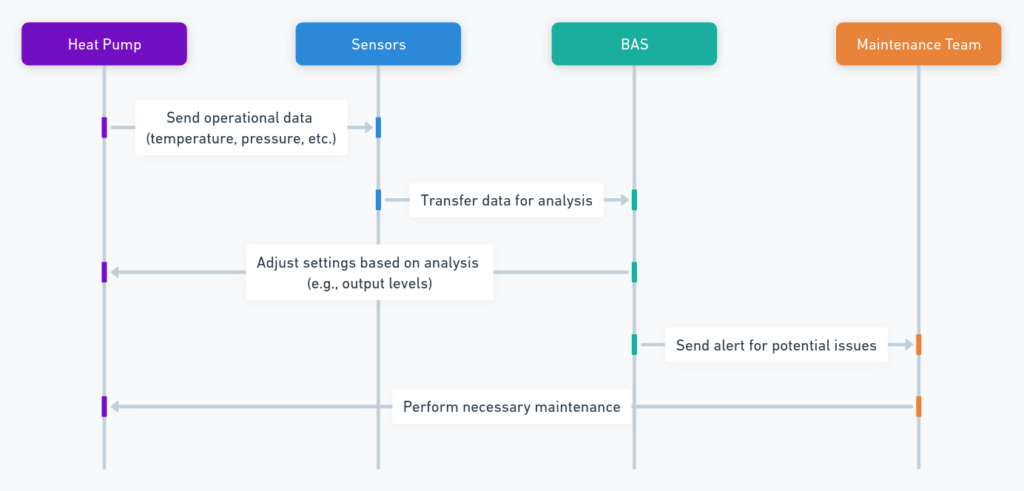Sustainability is no longer a buzzword—it’s a movement reshaping the way buildings are designed and operated. Governments are tightening carbon emissions targets, property managers are hunting for operational efficiencies, and tenants demand comfort without the guilt of wasting energy. Enter the modern heat pump: a technology that has quietly undergone a revolution, transforming into a versatile, data-driven powerhouse for energy-efficient buildings.
When paired with a BAS, today’s heat pumps do much more than heat or cool. They orchestrate a ballet of efficiency, comfort, and sustainability. Let’s explore how these systems are rewriting the rules for modern building management.
The Traditional Heat Pump Challenge
Heat pumps have long been heralded as energy-efficient systems, transferring heat instead of generating it. However, older models faced a critical challenge in cold climates: as temperatures plummeted, their heat extraction capability waned. Traditional air-source heat pumps relied on refrigerant cycles to absorb and transfer heat, but sub-freezing conditions significantly reduced the available heat energy, impairing their ability to maintain comfortable indoor temperatures.
The core issue lay in the limitations of refrigerants and heat exchanger efficiency. At low temperatures, refrigerants struggled thermodynamically, reducing heat transfer rates. Frost buildup on outdoor coils compounded the problem, forcing frequent energy-intensive defrost cycles that disrupted heating. As a result, older systems often required supplemental heating sources—typically electric resistance coils or fossil fuels—undermining the efficiency they were designed to provide.
Dynamic Energy Management: Tailoring Comfort, Cutting Costs
Traditional HVAC systems tend to work like the tortoise and the hare—either racing at full capacity or crawling inefficiently. Modern inverter-driven heat pumps break this cycle by adjusting their output in real-time to match the building’s needs. This precise modulation slashes energy waste while maintaining consistent comfort.
When integrated with a BAS, the synergy becomes even more compelling. Sensors, weather forecasts, and occupancy data feed into the BAS, enabling the system to fine-tune heat pump performance. For example, during peak demand, the BAS might ease output to conserve energy. Conversely, when occupancy surges, it ramps up capacity to keep occupants comfortable.
The result? Energy use that’s as dynamic as your building’s needs—without compromising tenant satisfaction.

Seamless System Integration: Connecting the Dots
Modern heat pumps don’t just play solo; they’re team players. Air-to-water heat pumps, for instance, can integrate with hydronic systems like underfloor heating or fan coils. Through a BAS, these components coordinate seamlessly, ensuring optimal performance across the entire HVAC ecosystem.
Imagine this: A BAS adjusts water temperatures based on outside weather, shifts heating zones during peak occupancy, and syncs everything with time-of-day schedules. By eliminating redundancies and conflicts, the system runs like a Swiss watch—efficient and precise. Occupants experience consistent comfort, and facility managers enjoy energy savings that make CFOs smile.
Predictive Maintenance: Fixing Issues Before They Happen
Say goodbye to reactive repairs and hello to predictive maintenance. IoT-enabled sensors in modern heat pumps collect data on critical metrics like refrigerant pressure and compressor performance. This information flows into the BAS, where advanced analytics work their magic.
If a compressor temperature starts creeping up, the system flags a potential refrigerant issue. Maintenance teams get an alert before the problem escalates. This proactive approach minimizes downtime, trims repair costs, and extends equipment lifespan. Predictive maintenance isn’t just a strategy; it’s the future of facility management.

Sustainability Metrics: Proving Your Green Credentials
Sustainability goals are no longer optional—they’re the baseline for modern buildings. Heat pumps are key players in this arena, operating efficiently even in colder climates. Through a BAS, their performance can be tracked and reported in granular detail.
From carbon reductions to kWh savings, every metric becomes a story of environmental impact. These insights not only help secure government incentives but also bolster your case for green building certifications. Add renewable energy sources like solar or wind to the mix, and you’ve got a system that’s as eco-friendly as it is efficient.
Demand Response Programs: Grid-Friendly Flexibility
With power grids under increasing strain, demand response programs offer a win-win solution. Heat pumps integrated with a BAS can adjust energy consumption during peak periods, helping utilities maintain stability while saving building owners money.
Picture this: A BAS pre-cools your building in the morning when electricity is cheap, then coasts through the afternoon peak with minimal energy use. Utilities stay happy, tenants stay comfortable, and your energy bills stay low. In some cases, utilities even pay you for participating. Who knew being flexible could be so lucrative?
The Future: Heat Pumps as Automation Anchors
Modern heat pumps are no longer standalone appliances—they’re the linchpins of sustainable building automation. In colder regions, they’re often the deciding factor between meeting energy codes or falling short. And as AI and machine learning evolve, the synergy between heat pumps and BAS platforms will only deepen.
Imagine buildings that predict demand, adapt to occupant behavior, and optimize energy use autonomously. With their IoT-driven architectures, heat pumps are perfectly poised to lead this transformation.
Why Heat Pumps Are a Strategic Imperative
The journey toward smarter, greener buildings runs straight through heat pump territory. From dynamic energy management to predictive maintenance, these systems offer a trifecta of efficiency, sustainability, and comfort. Whether managing a single office or an entire campus, integrating heat pumps with a BAS isn’t just an upgrade—it’s a strategic move for future-proofing your operations.
In the words of the great Ferris Bueller, life moves pretty fast—so do energy standards. Don’t let your building get left behind. Embrace the heat pump renaissance and stay ahead of the curve.

